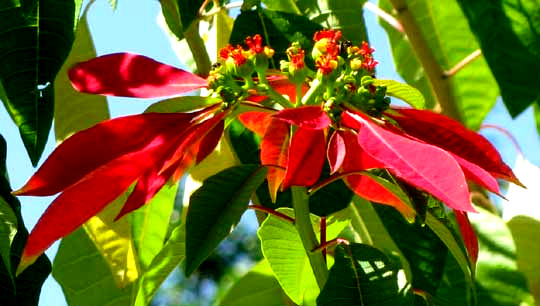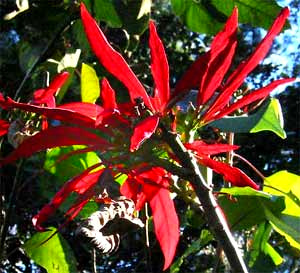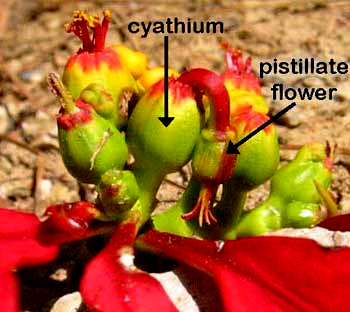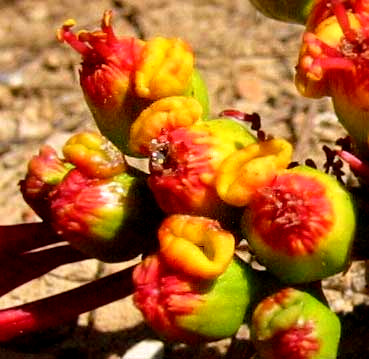Excerpts from Jim Conrad's
Naturalist Newsletter

from the November 20, 2011 Newsletter issued from Hacienda Chichen Resort beside Chichén Itzá Ruins, central Yucatán, MÉXICO
POINSETTIAS FLOWERING
In the pleasant little Maya village of Xocempich, the first on-the-road settlement north of Pisté, a family's Poinsettia is beginning to flower, as shown above. A close-up of a flowering head -- just to convince you that it's a real Poinsettia -- gloriously unfurls below:

I write "flowering head" instead of flower because the last picture shows many flowers, not one. When we met this species, EUPHORBIA PULCHERRIMA, back in Chiapas in 2008, we examined its flower peculiarities. That material is shown below.
Of course the Poinsettia you may soon be buying as a potted plant for the Christmas season is much different from what's in these pictures. Since the first Poinsettias were introduced into the US in 1825, from Mexico, many cultivars have been developed.
Cultivars fall into two main groupings: One is a little- or none-branching one and the other branches freely. The main cultivar mass-produced nowadays is a freely branching one producing several flower heads per plant and retaining its leaves longer than others. In the mid 1990s it was discovered that the free branching actually was a symptom caused by a disease organism, a phytoplasma. Kill the phytoplasma and subsequently produced clones don't branch.
The commercial Poinsettia, Euphorbia pulcherrima, is said to be native to southern Mexico and Central America, though I don't recall seeing it in the wild. Frequently, however, other species of the genus Euphorbia turn up with red bracts and/or Poinsettia-like flowering structure. Among such "Wild Poinsettias" we've seen Euphorbia cyathophora, shown at www.backyardnature.net/yucatan/poinsett.htm and Euphorbia heterophylla, on display at www.backyardnature.net/yucatan/wildpoin.htm.
from the January 21, 2008 Newsletter issued from Mexico's Southernmost State, CHIAPAS
POINSETTIA FLOWER ANATOMY
Our native-Mexican Poinsettias, which are flowering now, belong to the same family as Castor-Beans, the Spurge or Euphorbia Family. Therefore, it can be interesting to compare Poinsettia flowers with those of the Castor-Bean.
The Poinsettias possibly blooming in your house right now are herbaceous greenhouse productions of what in the wild grows to be a woody shrub ten feet tall and higher. Below, you can see the thick, woody, flowering branch-tip of a 10-ft-high tree near my place.

In that picture the red things are not flower petals but rather modified leaves called bracts. Because actual Poinsettia blossoms are very small and inconspicuous, the red bracts take over the job of attracting pollinators. Now take a look at the close-up below and to the left.

Neither are the yellow-green, cuplike things shown in the picture at the base of the large red bracts flowers. The cuplike thing labeled as a "cyathium" is a structures unique to the genus Euphorbia, of which the Poinsettia is one. Poinsettias are EUPHORBIA PULCHERIMA. The cyathium grows around several small individual flowers, somewhat similar to how a fig's flowers develop inside the fleshy fig.
So far there's little similarity between Castor-Beans and Poinsettias. But now we do come to a similarity, and that is that each plant bears strictly male flowers and strictly female flowers; both Poinsettias and Castor-Beans are monoecious. Unlike the Castor- Bean with its female flowers positioned above its male ones, however, Poinsettias cram their male and female flowers together inside the cyathium. The flowers are much reduced, each male one consisting of a single stamen while each female flower consists of a single pistil; neither flower type bears a calyx or corolla.
In each cyathium there are usually several male flowers but only one female one, and that female is attached in the cyathium's center. Moreover, the female flower does something extraordinary: It sits atop a stemlike pedicel that grows so long that it bears the female completely outside the cyathium, as shown in the above picture, where the female flower is labeled as the pistillate flower, because it consists of nothing but the pistil (stigma, style & ovary).
As in Castor-Bean flowers, the red starfish thingy atop the upside-down ovary is the feathery style. In the above picture you also see stamens and immature styles poking from other less-developed cyathia.

Above you see yet another similarity between Castor-Bean and Poinsettia flowers: They both produce waxy looking, yellow, goblet-like glands. It's just that Castor-Beans put their glands at the top of their petioles, while Poinsettias stick them on their cyathia.
Do you enjoy as much as I the esthetic experience of knowing to look for such things as unisexual flowers and waxy, yellow, goblet-like glands -- because of the family relationship -- but then finding the anticipated flowers and glands distributed in surprising places and with completely unexpected configurations?